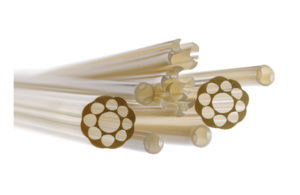
To achieve the highest-performing extrusion, both the component designer and the extruder must understand the many aspects of a medical tubing material such as polyetheretherketone (PEEK).
Jonathan Jurgaitis, Apollo Medical Extrusion by Spectrum Plastics Group
PEEK offers enhanced properties that make it an attractive tubing applications material for medical device designers and engineers. Its high strength, resistance to the most extreme chemicals and high-temperature dimensional stability work well in devices designed for cutting-edge neurovascular and orthopedic procedures as well as for mechanical components of medical and access devices.
Device designers, engineers and even processors need to know several things about PEEK to successfully incorporate it into a device or catheter.
It can take the heat
Experts consider PEEK a high-heat polymer because of its elevated processing temperature of around 700 °F. This means that tubing manufacturers cannot process PEEK on standard thermoplastic extruders but must instead outfit the extruders with higher-powered heaters. The metals of construction must be lower-thermal expansion alloys.
The high-heat aspect of PEEK comes into play in manufacturing devices that use multiple components, especially in fabrication processes that require thermal processing, such as over-molding, reflow processes and thermal welding. PEEK remains dimensionally stable at temperatures of 465 °F to 500 °F and has a melting point of 644 °F.
These “normal” PEEK temperatures are 200 °F to 300 °F are higher than typical, “low-heat” medical thermoplastics. This means that thermal processes to bond PEEK to other thermoplastics, such as thermal welding and reflow, will at best only have a mechanical bond to a PEEK part.
Additional design features may be necessary to ensure strong bonds between these thermally dissimilar materials. Machines to do this secondary thermal processing must also be capable of reaching the elevated processing temps for PEEK.
Less friction
PEEK has a low coefficient of friction, a beneficial property for many catheter applications, such as neurovascular or other procedures that use microbore tubing. PEEK’s coefficient of can be in the .35 range, compared with fluoropolymers, which land in the .1 to .2 range.
For microbore applications, PEEK allows smooth movement through the vasculature and access for devices without coatings or lubricious liners. These procedures can also benefit from the stiffness, push-ability and torque response of PEEK at diameters much lower than 2 French. To achieve similar performance, other materials would need to be not only braided but also have thicker walls, and end up costing much more. Many other applications, such as bushings, wear components for spinning, or sliding tools and tool access devices, can benefit from the lubricity of PEEK.
Why it works
PEEK is a semi-crystalline polymer, which means a portion of its molecules align and form crystalline structures. The bonds between the molecules in the crystalline regions are quite strong and require a lot of energy or force to loosen or break them. These strong bonds also give PEEK its extreme chemical resistance, its high-temperature thermal stability and its stiffness.
Some semi-crystalline materials, such as acetal, HDPE and polypropylene, will fully crystallize regardless of processing method, but it’s possible to freeze PEEK in an amorphous state before it can achieve its semi-crystalline state. In an amorphous state, all of PEEK’s properties decrease. This can harm medical components in situations like sterilization, exposure to extreme chemicals and repeated flex cycling, causing PEEK components to change shape and size, stress crack and underperform.
Material manufacturers typically do not state this, but the provided test values for PEEK on technical data sheets are based on fully crystallized test samples, so tubing that is not fully crystallized will not perform to the level that the device engineer may have expected for his or her application.
The standard state for PEEK products should be considered fully crystallized and only in some unique situations will a customer specify amorphous PEEK. The performance of PEEK in its amorphous state is less well known because there can be varying degrees of crystallinity that complicate how to characterize amorphous PEEK products. Achieving fully crystallized parts can be very challenging and may require a secondary annealing process, but this has its own challenges as PEEK parts can go through dramatic changes while being annealed, so inline crystallization of extruded tubing is the ideal method.
Versatility gives PEEK an edge
A tubing manufacturer can extrude PEEK into just about any configuration that can be achieved with low-heat materials, including microbore tubing, multi-lumens, thin-wall tubes, filament and profile shapes. Some aspects of making these shapes in PEEK will be different than their low-heat counterparts, but it can be done.
PEEK can also offer design options that are not possible with metal and achieve performance that no other low-heat material can approach. Working with an extruder that is experienced with PEEK and its extrusion nuances and special requirements will help designers use PEEK extrusions to their fullest in their medical applications.
Jonathan Jurgaitis is a senior extrusion engineer at Apollo Medical Extrusion by Spectrum Plastics Group. He has been in the custom medical extrusion industry since 2006, manufacturing catheter and medical device components, and has been part of the extrusion industry, in a variety of positions, since 1993. Jonathan’s extrusion focus for the last 10-plus years has been high-heat materials, such as PEEK, and other exotic and difficult-to-extrude materials.
The opinions expressed in this blog post are the author’s only and do not necessarily reflect those of Medical Design and Outsourcing or its employees.

